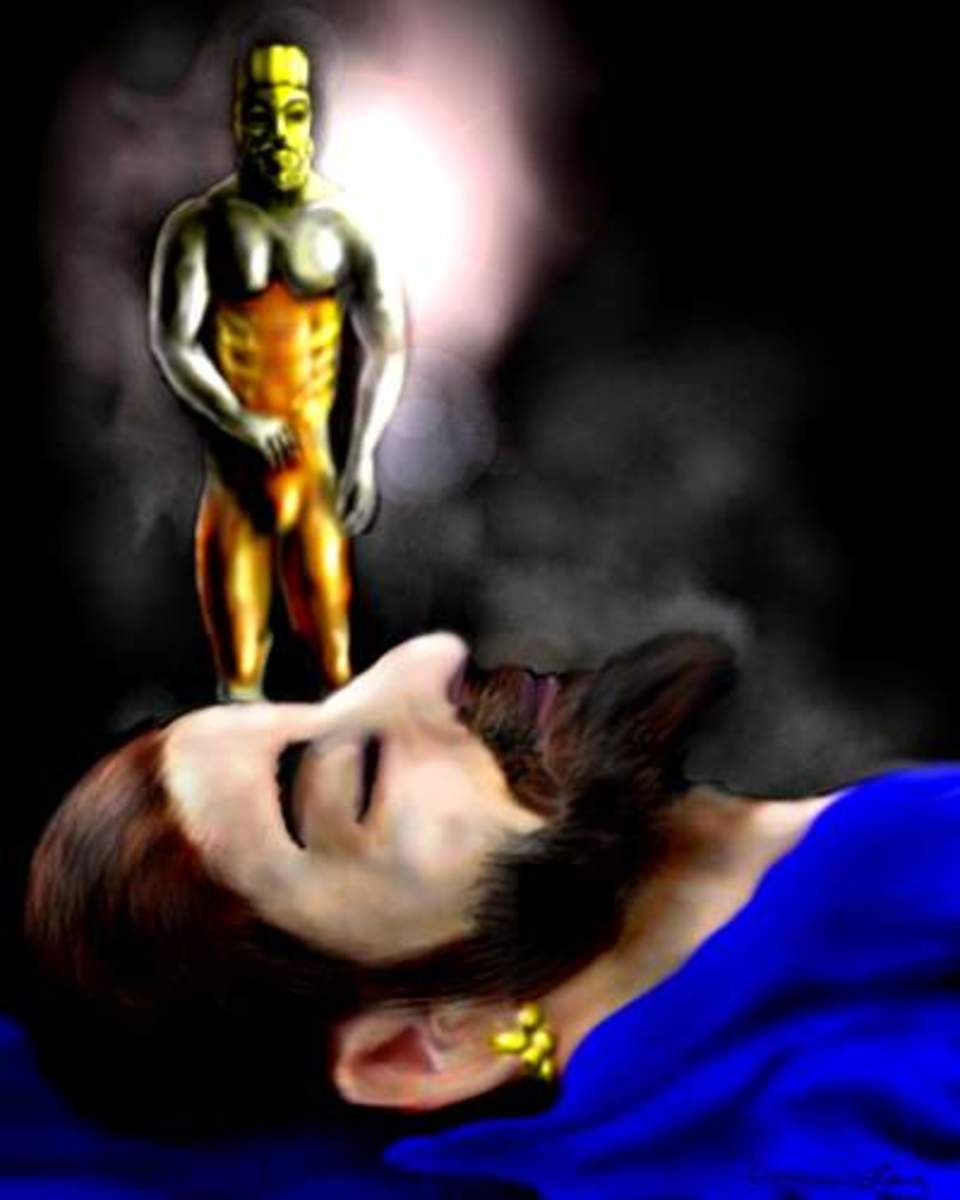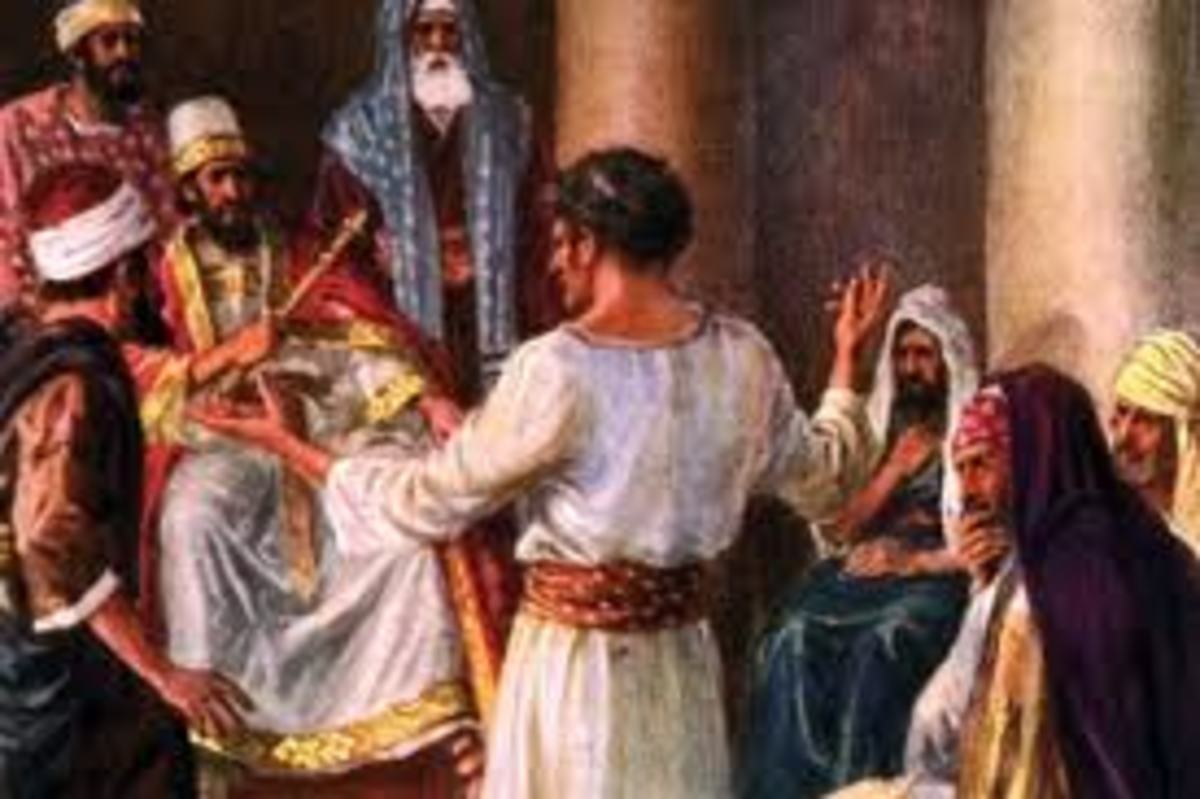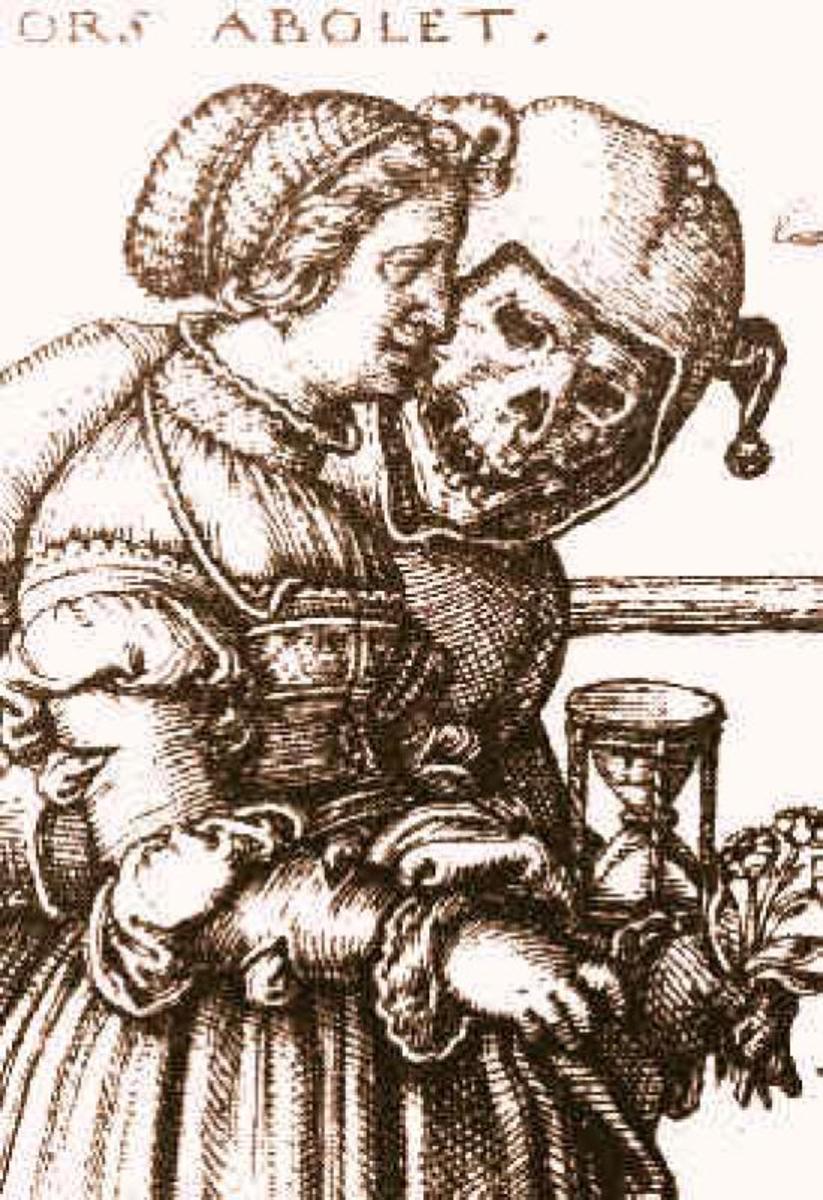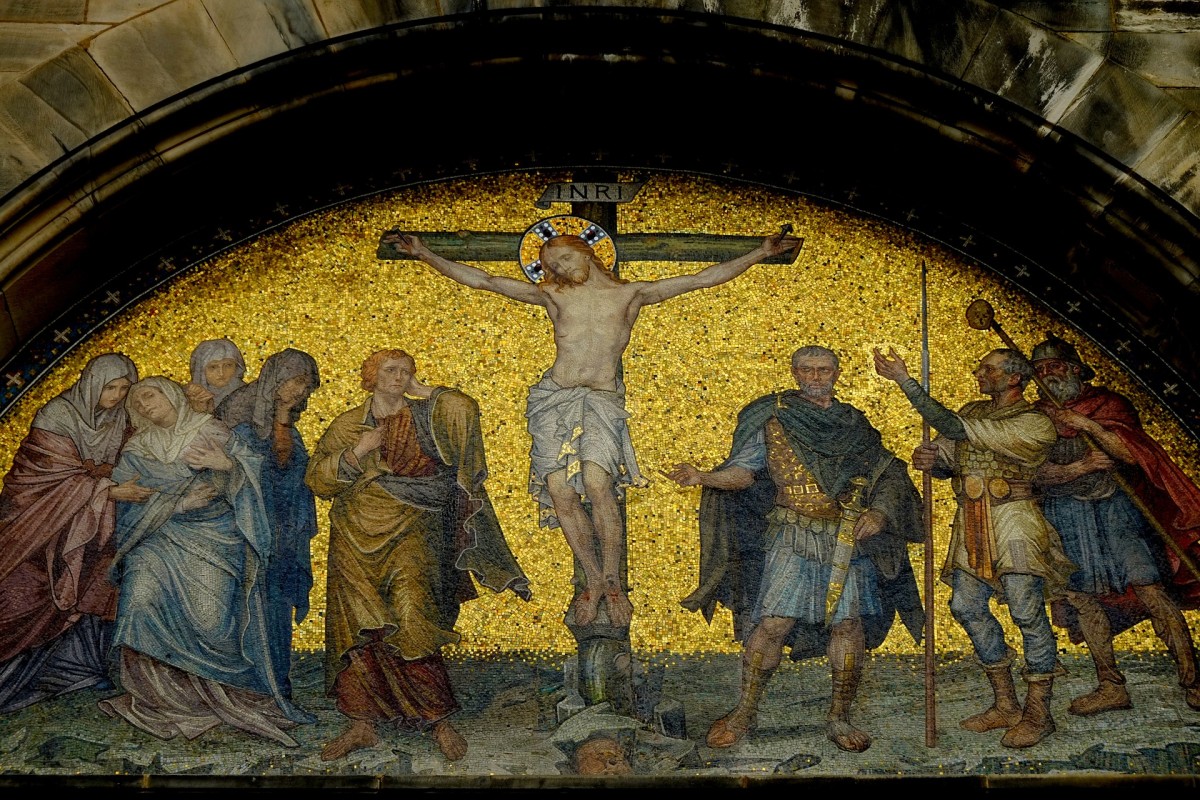Bible: What Does Daniel 7-8 Teach Us About Two Visions: The Four Beasts, and the Ram and the Goat?
Nebuchadnezzar--The Lion
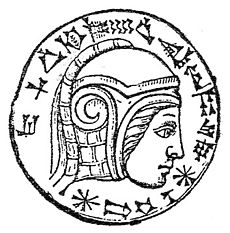
The Four Beasts
The prophet's first vision and an angel's interpretation of it comprise the bulk of this chapter.
As his account begins, Daniel hearkens back to the start of Belshazzar's reign (the time he received his dream) [v. 1].
[From this example, the reader surmises that chronology is not of utmost importance to Daniel].
He describes four great beasts—a winged lion, a bear, a leopard and a ten-horned monster—which arise out of the "Great Sea" (the Mediterranean region or the Gentile world) [vv. 2-8].
First, Daniel records that Someone/something plucks off the lion's wings, and compels this king of beasts to walk and think like a man (v. 4).
Next, he sees a bear-like creature, leaning to one side and gnawing greedily on three ribs, appear (v. 5).
A four-winged, four-headed leopard takes center stage next (v. 6).
Finally, the most awesome beast of all, the ten-horned fourth, Daniel observes wreaking much havoc (v. 7).
His attention subsequently focuses on one particular horn among the ten—although the prophet refers to it as "another horn," as though it were not grouped with the ten—which destroys three of his companions and spouts off with exceeding pride (v. 8).
One Like the Son of Man
view quiz statisticsThe Heavenly Assize
As the vision progresses, the scene changes; Daniel finds himself in the courtroom of “the Ancient of Days” (i.e., God) with many others, both seated and standing.
He describes God's garment and white hair, His fiery throne on wheels, and the burning stream before Him, as well as the multitude of servants attending him (vv. 9-10; cf. Rev. 4-5).
The court had convened to pronounce judgment upon a certain boaster on earth (v. 11).
According to Daniel, the other beasts' dominions end, yet the LORD allows them to live (v. 12).
"One like the Son of Man" appears before the Ancient of Days, "coming with the clouds of heaven" (v. 13; cf. Rev. 1, 14; Mt. 16:28, 29).
To this One, God gives everlasting dominion over the world's inhabitants (v. 14).
Grieved and troubled by this sighting, Daniel asks his attending angel to explain the dream to him.
[It is noteworthy that God does not give Daniel, the interpreter (by the LORD's permission) for Nebuchadnezzar and Belshazzar, the direct interpretation to his own dream!].
He seems concerned initially about the generalities of the vision: what the beasts are, and what happens to the kingdom (vv. 15-16).
Once these questions receive basic answers (vv. 17-18), however, Daniel seeks further information about the fourth beast, the ten horns, and the one proud horn among them (vv. 19-20).
He adds a detail that the vision deletes: this "horn was making war against the saints, and prevailing against them" (v. 21).
Verse 22 resumes with the last part of the vision: the saints' reception of the kingdom from the Ancient of Days.
[A near identity exists between the One like the Son of Man and the saints of the Most High.
However, it is clear that the two remain separate entities].
The Boastfur Horn
view quiz statisticsThe Boastful Horn
Next, Daniel records the angel's interpretation of the identities of the fourth beast, the ten horns, and the one boastful horn (vv. 23-27).
First, he mentions that the fourth beast is a powerful, destructive kingdom (v. 23).
[It refers historically to imperial Rome].
A “ten-nation confederacy” arises from this original kingdom, and still another "king" comes to power afterwards, which will put down three others.
Commentary: Revelation 13, 17 identify this empire as a future world power that Christ will destroy at His second coming.
As for the "king," he will blaspheme God, persecute believers for three and one-half years, and intend to change "times and law" (v. 25).
Meanwhile, back in the heavenlies, the Highest Court renders a judgment in favor of the saints.
These people set over them a king, who subsequently reduces the boastful one to zero forever (vv. 26-27).
After the vision ends, Daniel faints from mental and emotional exhaustion (v. 28).
Alexander the Great--The One-Horned Goat
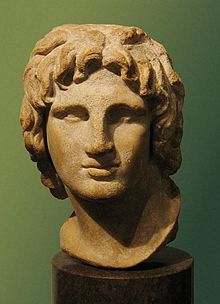
The Vision of the Ram and the Goat
Daniel 8
Two years later, Daniel receives another vision at a very specific location (Shushan [Susa], province of Elam, by the River Ulai) [vv. 1-2].
Again, he sees beasts, but this time they appear as a ram and a goat.
The ram, its two horns explicitly described, dominates all other beasts (vv. 3-4).
[These horns appear to represent the Medes and the Persians.]
As for the goat, it makes an unusual entrance, flying onto the scene ("came . . . without touching the ground") [v. 5].
This description undoubtedly alludes to “its” ability to travel and conquer quickly.
The latter possesses only one horn, like a unicorn (v. 5).
In a fierce battle, the mighty ram meets “more than his match” in the “person” of this one-horned goat (namely, Alexander the Great) (vv. 6-7).
Later, this goat, having grown very great, breaks his horn, and four horns replace it (four generals) [v. 8].
Antiochus Epiphanes
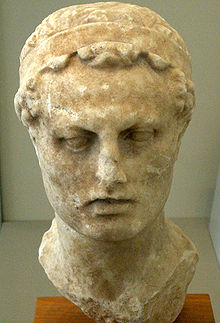
The "Little Horn" and Antiochus "Epiphanes"
Out of one of these horns emerges a little horn which becomes exceedingly powerful, even to the extent of challenging "the Prince of the host" (vv. 9-11).
He gains control over the temple worship in the "Glorious Land," and commits abominations there.
His wicked actions, however, go unrequited (vv. 11-12).
Daniel then overhears an angelic conversation, discussing the duration of the horn's desecrations (v. 13), and learns that about seven years (2300 days) will pass before the sanctuary is cleansed (v. 14).
Knowing that Daniel is at a loss to understand the vision, God sends the angel Gabriel in the form of a man to disclose to him not only the time of the vision's fulfillment, but also the specific meaning of the animals in symbol (vv. 15-22).
[Note the prophet's emotional and physical reactions to being in Gabriel's presence: sleep-inducing fear, emotional exhaustion, and physical illness (vv. 17-18, 27)].
As in chapter seven, the Medes, Persians, and Greeks appear as future world powers (vv. 20-21).
But unlike that chapter, this vision does not mention Nebuchadnezzar (the lion), and it only prefigures the Roman prince/Antichrist (the little horn) in the person of the Syrian ruler, Antiochus Epiphanes, who is represented as a little horn arising from the Greek empire.
Daniel makes no mention of the Roman Empire here (cf. vv. 9, 22-23).
Gabriel describes Antiochus as
(1) fierce in appearance,
(2) sinister in his ways,
(3) diabolically powerful, politically,
(4) having destructive designs for the Jews,
(5) prosperous,
(6) cunning,
(7) politically corrupt and deceitful, and
(8) proud of heart to an inordinate degree.
His end will mirror that of the end-time Roman dictator (vv. 23-25; cf. 2:45).
The angel admonishes Daniel to "seal up the vision" (v. 26); apparently, the time element should not concern the prophet, for the vision will find fulfillment in the distant future.
Again, Daniel faints from fatigue and astonishment (v. 27).
© 2013 glynch1


